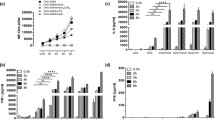Conclusions
Our data demonstrate a new ligand specificity of TLR2, since LcrV is the first known secreted and non-lipidatedvirulence-associated protein of a Gram-negative bacterium utilizing TLR2 for cell activation. We conclude that yersiniae might exploit host innatepattern recognition molecules and defense mechanisms to evade the host immune response.
Access this chapter
Tax calculation will be finalised at checkout
Purchases are for personal use only
Similar content being viewed by others
References
Motin, V. L., Nakajima, R., Smirnov, G. B., and Brubaker, R. R, 1994, Passive immunity to yersiniae mediated by anti-recombinant V antigen and protein A-V antigen fusion peptide. Infect. Immun. 62:4192–4201.
Nedialkov, Y.A., Motin, V.L., and Brubaker, R.R., 1997, Resistance to lipopolysaccharide mediated by the Yersinia pestis V antigen-polyhistidine fusion peptide: amplification of interleukin-10. Infect. Immun. 65:1196–1203.
Sing, A., Roggenkamp, A., Geiger, A. M., and Heesemann, J., 2002a, Yersinia enterocolitica evasion of the host innate immune response by V antigen-induced IL-10 production of macrophages is abrogated in IL-10-deficient mice. J. Immunol. 168: 1315–1321.
Sing, A., Rost, D., Tvardovskaia, N., Roggenkamp, A., Wiedemann A., Kirschning, C.J., Aepfelbacher, M., and Heesemann, J., 2002b, Yersinia V-antigen exploits toll-like receptor 2 and CD14 for interleukin-10 mediated immunosuppression. J. Exp. Med. 196: 1017–1024.
Author information
Authors and Affiliations
Editor information
Editors and Affiliations
Rights and permissions
Copyright information
© 2004 Kluwer Academic Publishers
About this chapter
Cite this chapter
Sing, A. et al. (2004). Mechanisms of Yersinia enterocolitica Evasion of the Host Innate Immune Response by V Antigen. In: Skurnik, M., Bengoechea, J.A., Granfors, K. (eds) The Genus Yersinia. Advances in Experimental Medicine and Biology, vol 529. Springer, Boston, MA. https://doi.org/10.1007/0-306-48416-1_33
Download citation
DOI: https://doi.org/10.1007/0-306-48416-1_33
Publisher Name: Springer, Boston, MA
Print ISBN: 978-0-306-47759-1
Online ISBN: 978-0-306-48416-2
eBook Packages: Springer Book Archive




